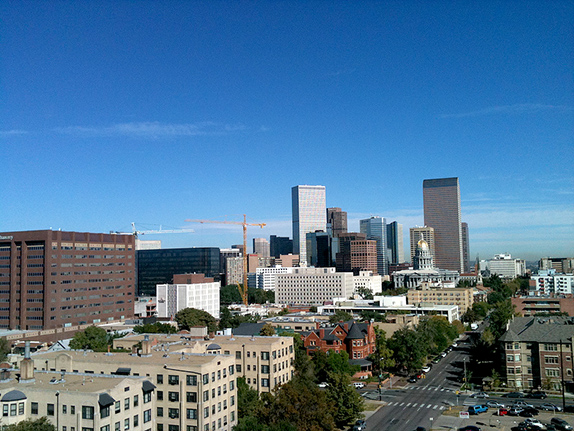
“Dimver,” that’s all how all seven surviving long-term residents of Colorado pronounce the capital city’s name. I was born in Dimver. I grew up in Dimver. All those Dimver years remain a blur to me. When I am in Dimver, even now, I never know who I am, or where I am, for that matter. What’s more, I don’t care. I have that Dimver attitude.
In an odd sense the identity problems that plagued the good old Dimver Days when I was a total amnesiac kid still haunt the Queen City of the Plains. Dimver wants to be somewhere rather than stuck out on what used to be plains and grasslands before it was a contiguous Wal-Mart and IKEA complex. Dimver wants to be somebody, John Elway, perhaps. Dimver wants to be permanent, a monument to the eternal thrumming present. Dimver does not want to be a cowtown.
Instead Dimver doesn’t know where it is and where it hid the macrophage that’s eating at its tiny soul. Most of all, Dimver loves money and wired-in success and would just as soon forget about everything to do with the bad old cowtown days. Dimver has a hell of a football team that anchors the city and fills the identity gap.
Here we are at South Colorado Blvd. and Alameda, an endless river of cars where there used to be a gas station that pumped ethyl and a disturbing weird sign with a mad winking cow that leered at the passing motorist, “Howdy folks! Welcome to Cowtown!” Cowtown— there’s that dreaded word again, the image Dimver wants to leave buried in the thin historical archive that is ignored and forgotten by those who have moved to the Queen City of the Plains.
Most people who have moved to Dimver from elsewhere look about twelve years old. They can be 30, or 40, or 80, but they all still appear to be twelve years old and they all smile a lot no matter what terrifying signals reality sends, and these seeming twelve year olds all drive very fast cars capable of going from 110 to three or two mph in fifteen seconds, so these smiling pre-adolescents can navigate all the inexplicable and sudden road snarls occurring as if by Jedi magic around Colorado Springs heading into Dimver and smiling, they are always smiling.
These negative energy vortices where one may be trapped for hours of roadcrawl and of incredible smiling—these are the times of blessing, adding a zesty underlying emotional fragrance of fear and aggression, an affective Irish Spring scent that cling to everything eastern slope suburban Coloradoish. The dedicated Nuevo Coloradan learns, while always smiling, to lane jockey and gun the engine from sunrise till sunset. They say one ages faster when shanghaied in a Colorado traffic jam.
“PlEASE REPORT INCIDENTS OF ROAD RAGE OR AGGRESSIVE DRIVING,” screams the sign on I-25 near Castle Rock. The Black Forest fire, David Holmes, Dylan Klebold, Eric Harris, and now Karl Pierson—Why Colorado? Why Dimver? What gives? The answer is simple—
Bland Rage.
Successive waves of twelve-year-old looking newcomers, hoards of bland tablet-bearing, smart-phone bedecked newbies in quietly raging droves and flocks, young, affluent, liberal, professional twelve year olds, and all of them smiling.
When I grew up in Dimver no one dared to ever smile. Smiling was considered a form of weakness; you could drive to the great outback in half an hour, but so what, you never broke a smile. And now, it’s half a week trip, a whole week from Dimver west to the mountains if you start on Friday, but still they are all smiling as they lane jockey west. Why?
Everyone knows Colorado is a land of soul-searching mountain beauty. The Von Trapps would have loved Colorado. The Von Trapps, as God-loving libertarians would have voted for recreational marijuana, so the pot tourists on their five-thousand-dollar-a-ticket dope buses could toke up and take rides up to Central City to see the face on the bar room floor. Actually most of the libertarians huddle in nameless mountain hollows and other rural redoubts. A lot of these folks don’t like weed. They grumble about seceding from the state.
Behind the bland essence that clings around the Dimver scene, an unspecified rage has always lurked. Dimver struggles to re-create its bland self from the thin tissue of the present, working to obliterate the rage, obliterate the past, and so repeating crucial errors again and again. Dimver’s business cycle follows a predictable, catastrophic and manic-depressive cycle from boom to bust to boom again. This was true in the mid 19th century when HAW Tabor warned Baby Doe not to forget the Matchless Mine and it’s true today. Right now Dimver and Colorado are experiencing the bland and highly lucrative euphoria of the recreational pot economy.
Dimver is the only city in the known universe to go from barbarism to decadence, from adolescence to Alzheimer’s with no intervening stages. Right now Dimver is in the ecstatic phase. But make no mistake about it; recreational marijuana is all about money. Dimver, victim of economic manic-depressive amnesia, has experienced the dizzying upward spiral of ever-escalating wealth, and then equally dizzying downward spiral to financial ruin and hard times over and over and over again. Dimver’s short and long-term memory are both shot from the sheer stress.
On that historic day when Pot became legal, I wanted to go out and photograph all the excitement to share with readers back home in Nuevo Mexico. I thought people would show up in hoards around the state capitol wearing hippy clothes, jester consumes, playing hand drums and zithers in outsized pink sunglasses, dancing half naked and reveling in sheer joy.
Instead, any potential excitement was quickly smothered in bland. If you think it’s really stimulating to watch people stand in lines for hours and days on end, then Booday in Dimver would set your soul to yearning, yearning for the sound of a cash register clanging over and over again as lawyers, investment brokers, and other professional types ponied up for the first legal pot at the various outlets blabbed about in the Dimver Post, what passes for a newspaper in the Mile High City.
Most of the paper is a watered-down version of USA Today that makes the Albuquerque Urinal look like the New York Times. The paper’s Marijuana Tsar, a reporter who dedicates his life to covering pot gourmet cooking, pot history, pot gardening, pot faqs, pot unfaqs, now does most of the local coverage.
I couldn’t really take a picture of pot prices spiraling ever upward as the undeterred marijuana tourists were all busy lining up to get their stuff so they could jump on the pot bus where things were considerably more mellow and they could insulate themselves from the prevailing invisible mist of bland rage that steamed up from the Dimver streets.
("Dimver" skyline photo by FionaG999)



Responses to “Dimver—Report from Blandolandia”